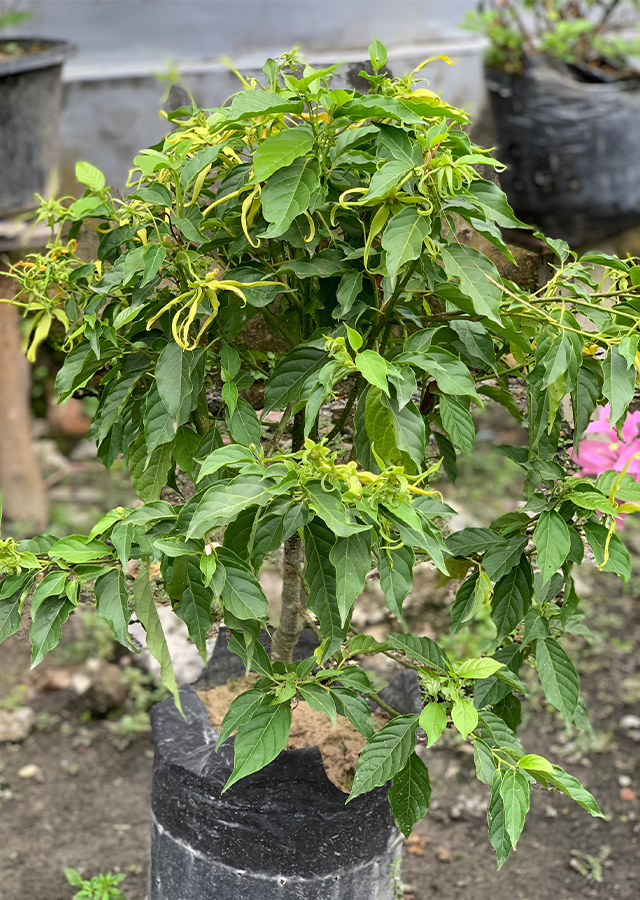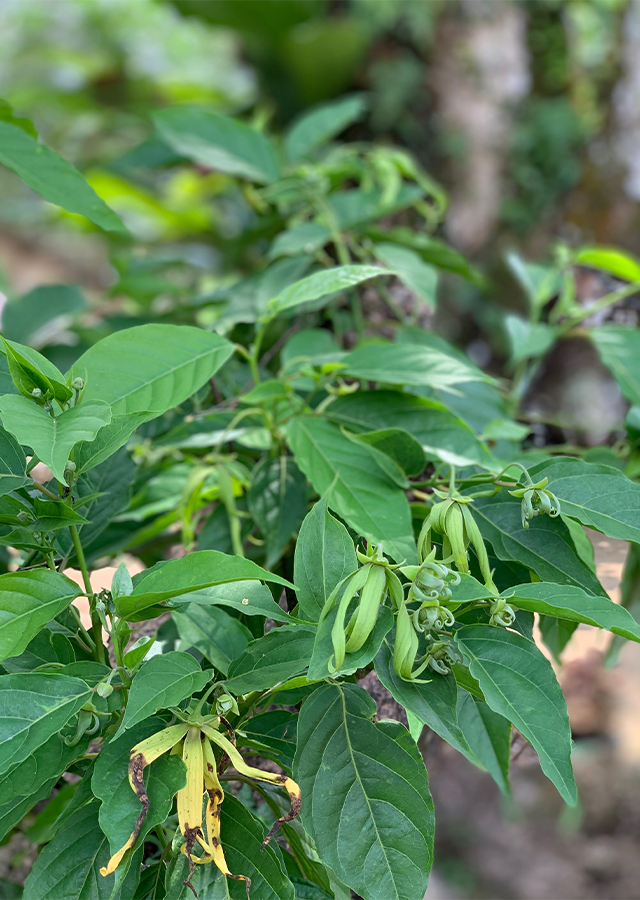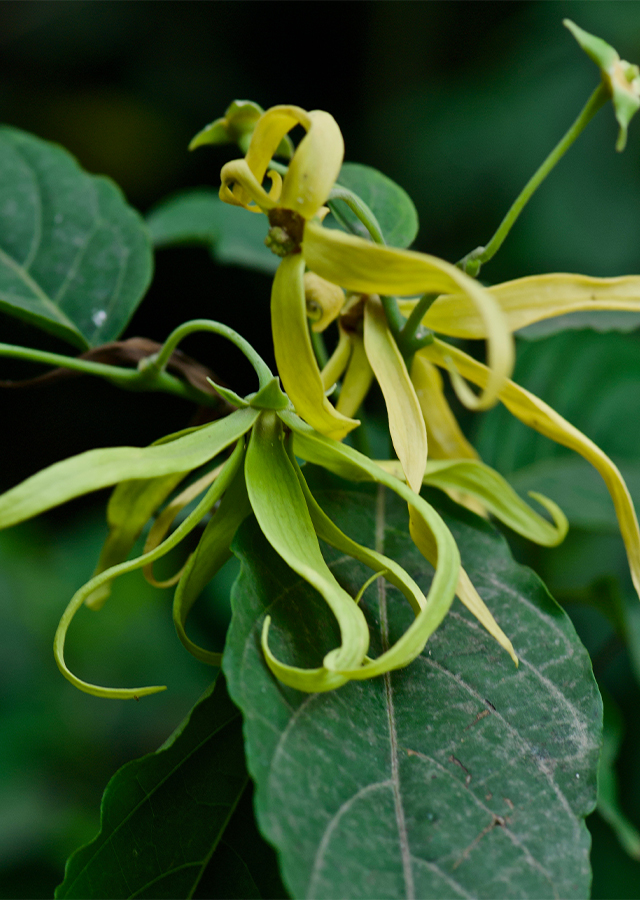Ylang-ylang
Cananga odorata (Lam.) Hook.f. & Thomson
Annonaceae
Location in our garden
Principal



Synonym
Cananga scortechinii King
Canangium mitrastigma (F.Muell.) Domin
Canangium odoratum (Lam.) Baill. ex King
Habitus
Shrubs. Small-sized shrub, compact, able to grow to about 1 - 2 m tall
Part Used
Leaves
Bark
Flowers
Growing Requirements
Drought Resistant
Habitat
Forest
Overview
Cananga odorata originates from Indochina, Malesia and tropical Australia and was introduced by humans to the Americas, China, India and Africa for a variety of commercial purposes, including for its fragrant perfume oils. Extensive literature survey demonstrated that Cananga is a medicinal and aromatic plant with a vast spectrum of pharmacological activities having considerable importance in agricultural and consumer products industries.
Vernacular Names
Xiao yi lan (Chinese), Canang odorant (French), Ilang-ilangbaum (German), Apurvachampaka (India), Iraniran noki (Japanese), alang-ilang (Philippines) Kenanga (Indonesia), kadatnyan (Myanmar) and Kananga (Malay).
Agroecology
It thrives in the more humid lowland tropics, at elevations below 1,200 m, and grows best in areas where annual daytime temperatures 20-30°C. It can be killed by temperatures of 5°C or lower. Average annual rainfall in the range of 1,500-2,000 mm is preferred. In a sunny position, it prefers fertile, moist but well-drained soil. A pH in the 5.0-6.5 range is preferred. When they are about 10 years old, trees can achieve full production of essential oils.
Morphology
Morphology
- Bark - smooth, gray, branches spreading horizontally.
- Leaves - simple, alternate, exstipulate, oblong to broadly elliptic, large, 3–6.5 cm across, 8.5–29 cm long, with distinct venation pattern.
- Flowers - drooping, long-stalked, with six narrow, greenish-yellow (rarely pink) petals, rather like a sea star in appearance.
- Fruits - Monocarps 10–16, ellipsoid or oblong-obovoid, 1.5–2.3 cm. long, glabrous.
Cultivation
Propagated through seeds and stem cuttings.
Chemical Constituents
Essential oils, lactones (isosiphonodin and canangone (a new terpenoid spirolactone)), liriodenine, anonaine, rroemerine, ushinine, canangine (eupolauridine), steroids, alkaloids, glycosides, saponins, phenols, tannins, flavonoids, amino acids, and coumarin.
Traditional Medicinal Uses
Medicinal uses
- Flowers are antipruritic, antifungal, antiseptic and sedative, relieving tension, lowering blood pressure and reducing fever, and the essential oil obtained from them. It is also said that they are aphrodisiacs.
- The antibiotic, antioxidant, antidiabetic, antifertility, antimelanogenesis, insect repellent, antihyperglycemic, sedative and soothing properties are antimicrobial, insecticidal and anti-inflammatory and anti-biofilm activities.
Traditional uses
- Leaves: used in child diarrhoea therapy. In a treatment to treat boils, the leaves are also used. They are rubbed to treat itching on the skin.
- Bark: against scurf is added. For the treatment of stomach ailments such as nausea, indigestion and colic, an infusion of bark is used. Pressed-bark fluid is used to treat toothaches and migraine headaches.
- Seed: used externally for the treatment of intermittent fever.
- In the treatment of malaria, dried flowers are used and the new flowers are made into a paste to treat asthma. They are used to treat skin irritations, conjunctivitis, boils, and gout when applied externally. To cure impotence and frigidity, they are applied to bath water. In aromatherapy, essential oil is crucial when used in the treatment of tachycardia, rapid respiration, hypertension, gastrointestinal infections and psycho-sexual complaints.
- The strongly fragrant yellow lower of C. odorata has been reported to be used to enhance the scent of coconut oil before being used for massage by Polynesians live in South Paciic islands
Part Used
Reference Sources
Holdsworth, D.K. (1990). Traditional medicinal plants of Rarotonga, Cook Islands Part I. Pharmaceutical Biology 28(3): 209–218.
Kew's Economic Botany collection in The State of the World’s Plants Report–2016. (2016). Royal Botanic Gardens, Kew https://stateoftheworldsplants.org/2016/
Tan, L.T.H., Lee, L.H., Yin, W.F., Chan, C.K., Kadir, H.A., Chan, K.G., Goh, B.H. (2015). Traditional uses, phytochemistry, and bioactivities of Cananga odorata (Ylang-Ylang). Hindawi Publishing Corporation, Evidence-Based Complementary and Alternative Medicine 2015: 1-30. http://dx.doi.org/10.1155/2015/896314

